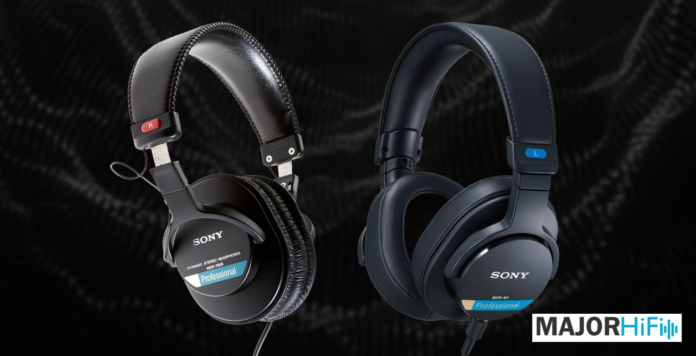When it comes to classic studio headphones, the Sony MDR-7506 has long held an iconic status, valued by audio engineers, musicians, and producers alike for its robust design and reliable, no-nonsense sound profile. However, Sony’s new MDR-M1 steps in as a modern, refreshed take on this classic, bringing several enhancements in design and sound performance. While both headphones retain similar driver configurations and build philosophies, the M1 makes significant upgrades in aesthetics, comfort, and audio depth. If you’re debating between the well-worn reliability of the 7506 and the stylish versatility of the M1, this comparison breaks down exactly where each headphone shines.
What You Get
| M1 | 7506 |
|
|
Look & Feel
When looking at the two headphones, the 7506 seems like a more rugged version of the M1, which would make sense due to one being just released. The 7506 is still very durable headphone as it’s been a handy tool for audio producers for multiple decades now. While the M1 has tons of upgrades in appearance and comfort, you cannot fold them the same way. The M1 is still light and easy to pack though with earcups that turn flat. Overall, the M1 is a true upgrade in terms of design. It keeps the main design of the 7506, while being lighter and featuring better padding.
Design
The M1 and 7506 use the same driver configuration, with the only main difference being their tuning. They both use 40mm dynamic drivers with neodymium magnets. When you look at the specs you’ll notice that the M1 feature a wider frequency response of 5Hz-80kHz and a lower impedance of 50 Ohms. The difference in resistance shouldn’t play much of a factor in getting both of these headphones to drive from any headphone output.
Soundstage
While the 7506 never had the biggest soundstage, you could always rely on it for an accurate mix thanks to its imaging capabilities. The M1 goes a step further, offering a sound with a broader wingspan. They both have clear barriers on how far the soundstage can expand being closed-back headphones, but the M1 brings a larger scale compared to the 7506. In terms of spatial accuracy though, both of these headphones are at the same level. The superior separation of the M1 allows for more precise localization, but the 7506 still shows a clear balance between the left and right channels.
Low End
One of the biggest differences between the M1 and the 7506 jumps out at you very quickly. The bass of the M1 has a much more significant presence while still being highly accurate. With the 7506 you get a flat even presentation of bass frequencies that are uncompromised, but the M1 feels more developed in its sub-bass frequencies. The M1 offers more lift and bloom underneath its clear and balanced response. Both headphones are capable of judging the low-end from a mixing perspective, but the M1’s enhanced layering opens up the bass in a way that might be more revealing.
Mids
Both headphones share tons of helpful midrange properties that make them ideal for critical listening. They contain flat frequencies that establish a realistic presentation of instruments and vocals allowing you to easily asses the timbre and make key decisions when mixing. The M1 seems to favor the low mids a bit more than the 7506, but the bump is only just noticeable. You get slightly crisper frequencies from the 7506, but both headphones make it easy to extract detailed notes and textures.
Highs
With the M1, much is done to smooth out the more sibilant qualities of the 7506. It was never harsh or fatiguing, but the highs were never that enjoyable to listen to. The M1 tries to control the highs and tighten them up, and it results in a smoother surface. Both headphones have high-end frequency responses that are still very accurate, but the M1 is definitely more comfortable to listen to for long hours.
Summary
The Sony MDR-M1 redefines what a “modern classic” could be, retaining the foundational elements of the 7506 while adding valuable updates in comfort, style, and bass response. For those who have relied on the 7506 for its honest sound and durability, the M1 offers a welcome evolution with its broader soundstage and smoother highs. Both headphones can handle critical listening and mixing tasks with ease, but the M1’s enhancements in sub-bass, separation, and comfort make it a compelling choice for today’s audio professionals. Whether you’re drawn to the legendary durability of the 7506 or the refined updates of the M1, both headphones reflect Sony’s legacy of high-quality audio.
The Sony MDR-M1 is available at Audio46.
MAJORHIFI may receive commissions from retail offers.








